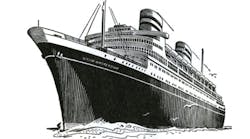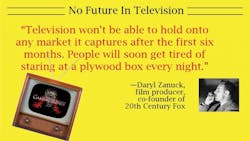Prepare for Disruption: 3-D Printing and the 'Unimaginable Science Fiction' of the Future
Author Jack Shaw deals almost exclusively in the future.
For the past 30 years, he has been helping businesses prepare for the next big thing -- from the rise of the Internet in the '90s to the potential of smart machines in the next decade. His job, he says, is to translate the "unfathomable science fiction" of the future into practical applications businesses can put to work today.
So when he kicked off the Cleveland edition of the Stratasys 3-D Printing Roadshow last month, the eager crowd of manufacturers in attendance naturally expected a healthy shot of 3-D printing futurism.
Instead, he opened with an archived photo of an ancient ocean liner and a story detailing the downfall of innovative laggards.
In the 1950s, he recalled, the ocean liner business was booming. At that point, they offered the only practical option for trans-Atlantic business travelers, boasting unparalleled comfort and luxury for a speedy five-day intercontinental trip.
Being unduly, cautiously conservative is a very high-risk course to take." - Jack Shaw
Not that there weren't other options, of course.
"It was possible then to fly commercially between North America and Europe," Shaw said. "But that would have meant subjecting yourself to 18 to 30 hours of cramped, cold, noisy, smelly discomfort with half a dozen stops along the way."
As late as 1956, he explained, the heads of the ocean liner industry were absolutely certain that business travelers would never forgo the comfort and convenience of crossing the ocean by ship.
And that was their downfall.
"Because jet travel hadn't been successfully commercialized, those who were dependent on the old way of doing things assumed that they could never be successfully commercialized," he said. "Therefore, they didn't take the steps they needed to take to prepare for the impact of disruptive technologies that would change the way their business functioned."
Because of that, he said, when Pan-
American Airlines introduced the first nonstop jet service from New York to London in August 1957, the ocean liners never saw it coming. In just six months, ocean passenger traffic plummeted 90% and has never recovered.
The point here, Shaw said, is simple: "Being unduly, cautiously conservative is a very high-risk course to take. If you want to minimize your risk and survive the next round of technological disruption, that means you've got to start taking some chances."
Lesson Learned
Fast-forward to today, Shaw says, and manufacturers are on the cusp of another technological disruption that carries equal power -- one, he argues, that will sink innovative laggards the same way PanAm's Boeing 707 sunk the ocean liners: 3-D printing.
To prove the point, he offered a scattershot of predictions of how 3-D printing could change the manufacturing business. He sees a future of shortened supply chains, inventory-less retailers, displaced CNCs and lights-out, autonomous factories capable of producing any part anywhere it's needed.
It's a future, he says, filled with potential that is still far beyond the capabilities of today's technologies. But that doesn't mean manufacturers can afford to wait.
"You've got to prepare for this coming wave," he said. "A key part of your planning process has got to be taking a shot at doing something different."
"Don't be afraid to experiment," he said. "Don't be afraid to fail."






